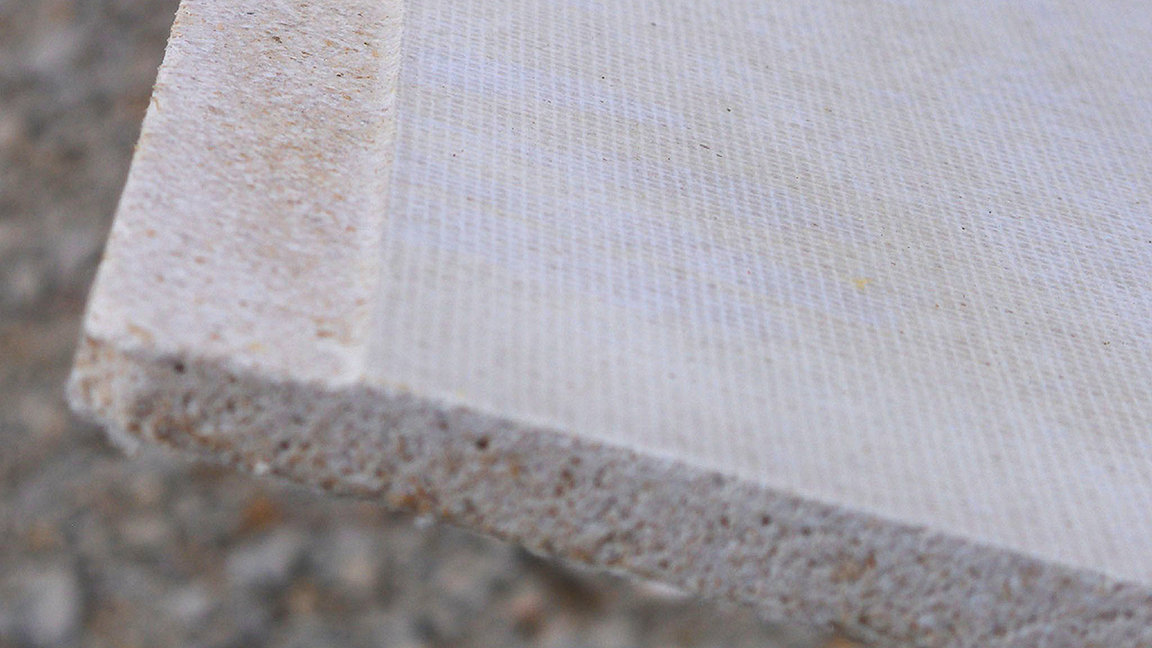
The UK has seen increased use of magnesium oxide boards over the past 20 years, typically as sheathing on framed or panelised building systems, or as backing to render or brick-slip systems. The rise in use follows the increased uptake of non-conventional and modern methods of construction.
In recent years – particularly since the Grenfell Tower tragedy and the Building Regulations amendments that followed – uptake has increased further. This is partly because magnesium oxide boards are often non-combustible, meeting the criteria for Euroclass A1 in BS EN 13501-1. They also offer some water resistance, are relatively lightweight and simple to cut to size on site, and are often used internally as flooring or backer boards for wall tiling.
Moisture issues and failures
Despite some advantages over cement or gypsum-based boards, poor-quality manufacturing methods can in some cases result in chloride salts, free chloride ions and organic materials such as woodchip being incorporated into magnesium oxide boards. Such substances can be hygroscopic and absorb moisture even from atmospheric water vapour, as well as from direct exposure to water.
Where the relative humidity is high over extended periods, moisture that collects in the pores of the board can weep out and accumulate as teardrops on the surface, potentially saturating adjacent materials. Dissolved chloride in this water can then corrode metal fixings or structural elements, so could present significant problems.
While there is no evidence yet of widespread board failures in the UK, problems have most notably been reported on Danish buildings in a study published in 2015, where fixings and structural elements were found to have corroded due to the dissolved salts and elevated organic content. Studies in Australia and Canada have also described similar problems to those seen in Denmark.
In some of these cases, the boards themselves failed or nearby timber absorbed moisture from them. But since magnesium oxide boards are in most cases concealed, these issues are unlikely to be identified until fixings or structural elements begin to fail.
In the UK climate, intense or prolonged rainfall coupled with exposure to wide temperature ranges on some facades can result in moisture movement within a structure or rainscreen cladding system. This raises the humidity around magnesium oxide sheathing boards, potentially increasing the risk of such problems occurring. The effect can be exacerbated if the vapour control layer is applied to the warm inner side of the sheathing board.
Concerns over testing
Although various bodies have tested magnesium oxide boards and provided approvals and certification, these assessments are reportedly based on tests developed for other board materials. There are therefore concerns about the size of test samples, and the temperature, humidity and duration of exposure.
As a result, the Centre for Window and Cladding Technology (CWCT) has urged the industry to treat these products and approvals with caution, and to consider carefully whether magnesium oxide boards without appropriate approvals should be specified.
In spring 2020, a number of latent defect insurance and warranty providers – including NHBC, Premier Guarantee and LABC – went further, stating that they would no longer accept magnesium oxide boards on any schemes that they insure, effectively prohibiting the use of the material.
International standard
In response to these concerns – and to reassure specifiers and contractors – alternative testing and approval processes are being developed. In March, the Magnesium Oxide Building Board Trade Association (MOBBTA) announced that a draft publicly available specification was being prepared by BSI in consultation with experts in the field, potentially serving as a first step towards an international standard for magnesium oxide products.
An internationally recognised standard and appropriate testing method is quite righty seen by the industry as the most practical way to allow specifiers and installers to continue to incorporate these potentially problematic materials with the confidence that they will perform throughout all stages of a building's anticipated life cycle.
'In response to concerns about product assessment, alternative testing and approval processes are being developed'
Analysis and assurance
Whether specifying or installing magnesium oxide products or reviewing existing building fabric as part of a technical due diligence or defects analysis role, surveyors must consider whether the material and surrounding components are suitable for the intended use.
Quality assurance documentation must establish as much, and all associated guidance from bodies such as CWCT or MOBBTA must be fully considered; where necessary, specialist advice must be taken from a suitable professional such as a façade engineer.
Related competencies include: Building pathology, Construction technology and environmental services, Design and specification
